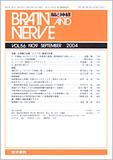Japanese
English
- 有料閲覧
- Abstract 文献概要
- 1ページ目 Look Inside
要旨 嗜銀性顆粒痴呆(argyrophilic grain disease:AGD)は,グレインと呼ばれる嗜銀性の顆粒状構造物が脳内に出現することを病理学的特徴とする痴呆性変性疾患であるが,現時点ではその臨床症状に関する報告は極めて少ない。今回われわれは,上肢の振戦で発症し,寡動や筋固縮も含むパーキンソニズムが出現し,発症8年後に記憶障害や失見当識,易怒性や易刺激性が出現した1症例を経験した。本症例の臨床診断は,痴呆を伴うパーキンソン病(Parkinson's disease with dementia)であった。しかし,病理学的には,桃核に神経細胞脱落とballooned neuronsとグレインの出現,さらに海馬・海馬傍回に多数のグレインとcoiled bodyの出現を認め,AGDと診断した。黒質・青斑核などに神経細胞脱落やレビー小体の出現は見い出されなかった。以上の臨床病理像より,AGDの臨床亜型として,痴呆を中心とする臨床像以外に,“痴呆を伴うパーキンソニズム”が存在しうることが示唆された。
Argyrophilic grain disease(AGD)is a neurodegenerative dementia, which is neuropathologically characterized by the spindle-or comma-shaped argyrophilic grains scattered in the neuropil of hippocampal area. Several research reports have disclosed the pathological, biochemical and genetic characteristics of AGD, whereas the clinical aspects have not been fully investigated. Here we report an autopsy case of AGD. She developed tremor at age 63, and then developed dyskinesia, rigidity and gait disturbance. Thereafter, she had cognitive impairment and emotional disturbance at age 71, and died of pneumonia at age 76. She was clinically diagnosed as Parkinson's disease with dementia due to the presence of parkinsonism and dementia. Macroscopically, the brain demonstrated mild atrophy, and the weight was 1,240g. Many argyrophilic grains were found in the hippocampus and amygdala. Coiled bodies and ballooned neurons were also present, while Alzheimer-type neurofibrillary changes were mild, con-sistent with stage 2 of Braak's classification. This case was neuropathologically diagnosed as AGD. In contrast, no remarkable pathological changes, including neuronal loss and Lewy bodies, were found in the nigra, locus ceruleus and basal nuclei. On the basis of the above-mentioned clinicopathological findings, parkinsonism with dementia is considered to be one of the clinical manifestations of AGD.
(Received : April 28, 2004)

Copyright © 2004, Igaku-Shoin Ltd. All rights reserved.


